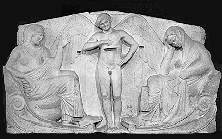| The Marble
 The marbles of both The Ludovisi and The Boston Throne went under Petrographic analysis to determine their origin. Samples from both thrones were compared to those from Naxos, Paros, Thasos and Mount Pentelicus; all quarries used by early Greek Sculptors. The marbles of both The Ludovisi and The Boston Throne went under Petrographic analysis to determine their origin. Samples from both thrones were compared to those from Naxos, Paros, Thasos and Mount Pentelicus; all quarries used by early Greek Sculptors.
 The marble of the Ludovisi and Boston Thrones were shown to be only slightly dissimilar. They were both found to be of dolomitic formation, like the sample taken from Thasos, whereas the other samples were calcite marble. Spectrographic analysis links the marble of Thasos with the Ludovisi and Boston Thrones. The marble of the Ludovisi and Boston Thrones were shown to be only slightly dissimilar. They were both found to be of dolomitic formation, like the sample taken from Thasos, whereas the other samples were calcite marble. Spectrographic analysis links the marble of Thasos with the Ludovisi and Boston Thrones.
The Surface
 Dirt Samples were taken from both Thrones, which differed in composition. Dirt Samples were taken from both Thrones, which differed in composition.
 Natural solvent action and root marks were found on the Boston Throne, like those found on the Ludovisi Throne. This indicates that the relief had been buried for a long time. Natural solvent action and root marks were found on the Boston Throne, like those found on the Ludovisi Throne. This indicates that the relief had been buried for a long time.
 Evidence of chemical weathering on the marble's patina was studied. W.J Young found this to be ancient, though many critics disagreed. Richard Newman repeated the test with more sophisticated equipment in 1995, drawing the same conclusion that the Boston Throne is of ancient origin. Evidence of chemical weathering on the marble's patina was studied. W.J Young found this to be ancient, though many critics disagreed. Richard Newman repeated the test with more sophisticated equipment in 1995, drawing the same conclusion that the Boston Throne is of ancient origin.
Conclusions
 The tests show that both Thrones are made from marble from the same place, Thasos, but not exactly the same area. The tests show that both Thrones are made from marble from the same place, Thasos, but not exactly the same area.
 The Boston Throne shows the same signs of being buried for a long period of time as the Ludovisi Throne. The Boston Throne shows the same signs of being buried for a long period of time as the Ludovisi Throne.
 W.J.Young suggests the dirt samples are different because they were buried "in the same general area but not in precisely the same location." W.J.Young suggests the dirt samples are different because they were buried "in the same general area but not in precisely the same location."
If these results do prove the above, it does not rule out the theory that the Boston Throne is a classicizing work from the 1st Century AD W.J Young and B. Ashmole imply that it is of ancient Greek origin.
Many critics refute the findings of these tests.
|
